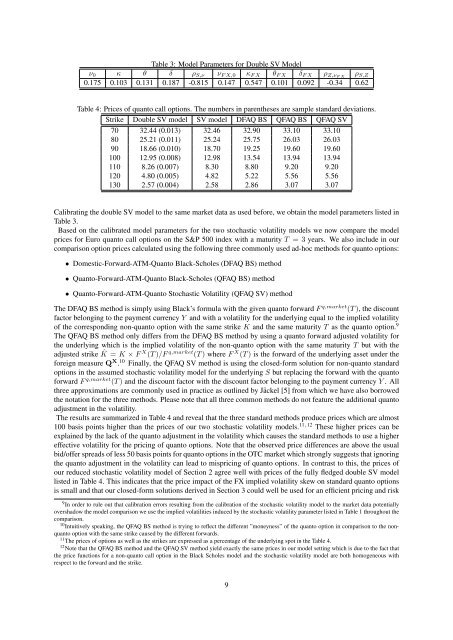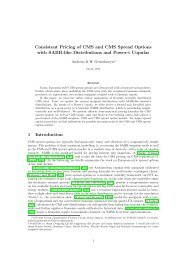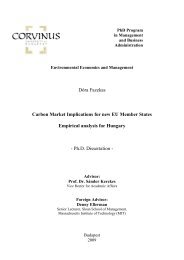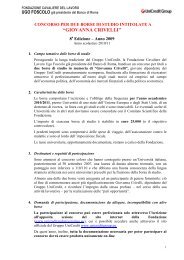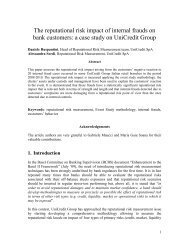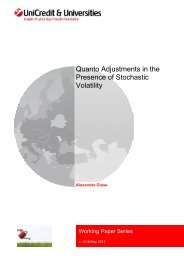Quanto Adjustments in the Presence of Stochastic Volatility
Quanto Adjustments in the Presence of Stochastic Volatility
Quanto Adjustments in the Presence of Stochastic Volatility
You also want an ePaper? Increase the reach of your titles
YUMPU automatically turns print PDFs into web optimized ePapers that Google loves.
Table 3: Model Parameters for Double SV Model<br />
ν0 κ θ δ ρS,ν νF X,0 κF X θF X δF X ρZ,νF X ρS,Z<br />
0.175 0.103 0.131 0.187 -0.815 0.147 0.547 0.101 0.092 -0.34 0.62<br />
Table 4: Prices <strong>of</strong> quanto call options. The numbers <strong>in</strong> paren<strong>the</strong>ses are sample standard deviations.<br />
Strike Double SV model SV model DFAQ BS QFAQ BS QFAQ SV<br />
70 32.44 (0.013) 32.46 32.90 33.10 33.10<br />
80 25.21 (0.011) 25.24 25.75 26.03 26.03<br />
90 18.66 (0.010) 18.70 19.25 19.60 19.60<br />
100 12.95 (0.008) 12.98 13.54 13.94 13.94<br />
110 8.26 (0.007) 8.30 8.80 9.20 9.20<br />
120 4.80 (0.005) 4.82 5.22 5.56 5.56<br />
130 2.57 (0.004) 2.58 2.86 3.07 3.07<br />
Calibrat<strong>in</strong>g <strong>the</strong> double SV model to <strong>the</strong> same market data as used before, we obta<strong>in</strong> <strong>the</strong> model parameters listed <strong>in</strong><br />
Table 3.<br />
Based on <strong>the</strong> calibrated model parameters for <strong>the</strong> two stochastic volatility models we now compare <strong>the</strong> model<br />
prices for Euro quanto call options on <strong>the</strong> S&P 500 <strong>in</strong>dex with a maturity T = 3 years. We also <strong>in</strong>clude <strong>in</strong> our<br />
comparison option prices calculated us<strong>in</strong>g <strong>the</strong> follow<strong>in</strong>g three commonly used ad-hoc methods for quanto options:<br />
• Domestic-Forward-ATM-<strong>Quanto</strong> Black-Scholes (DFAQ BS) method<br />
• <strong>Quanto</strong>-Forward-ATM-<strong>Quanto</strong> Black-Scholes (QFAQ BS) method<br />
• <strong>Quanto</strong>-Forward-ATM-<strong>Quanto</strong> <strong>Stochastic</strong> <strong>Volatility</strong> (QFAQ SV) method<br />
The DFAQ BS method is simply us<strong>in</strong>g Black’s formula with <strong>the</strong> given quanto forward F q,market (T ), <strong>the</strong> discount<br />
factor belong<strong>in</strong>g to <strong>the</strong> payment currency Y and with a volatility for <strong>the</strong> underly<strong>in</strong>g equal to <strong>the</strong> implied volatility<br />
<strong>of</strong> <strong>the</strong> correspond<strong>in</strong>g non-quanto option with <strong>the</strong> same strike K and <strong>the</strong> same maturity T as <strong>the</strong> quanto option. 9<br />
The QFAQ BS method only differs from <strong>the</strong> DFAQ BS method by us<strong>in</strong>g a quanto forward adjusted volatility for<br />
<strong>the</strong> underly<strong>in</strong>g which is <strong>the</strong> implied volatility <strong>of</strong> <strong>the</strong> non-quanto option with <strong>the</strong> same maturity T but with <strong>the</strong><br />
adjusted strike ˆ K = K × F X (T )/F q,market (T ) where F X (T ) is <strong>the</strong> forward <strong>of</strong> <strong>the</strong> underly<strong>in</strong>g asset under <strong>the</strong><br />
foreign measure Q X . 10 F<strong>in</strong>ally, <strong>the</strong> QFAQ SV method is us<strong>in</strong>g <strong>the</strong> closed-form solution for non-quanto standard<br />
options <strong>in</strong> <strong>the</strong> assumed stochastic volatility model for <strong>the</strong> underly<strong>in</strong>g S but replac<strong>in</strong>g <strong>the</strong> forward with <strong>the</strong> quanto<br />
forward F q,market (T ) and <strong>the</strong> discount factor with <strong>the</strong> discount factor belong<strong>in</strong>g to <strong>the</strong> payment currency Y . All<br />
three approximations are commonly used <strong>in</strong> practice as outl<strong>in</strong>ed by Jäckel [5] from which we have also borrowed<br />
<strong>the</strong> notation for <strong>the</strong> three methods. Please note that all three common methods do not feature <strong>the</strong> additional quanto<br />
adjustment <strong>in</strong> <strong>the</strong> volatility.<br />
The results are summarized <strong>in</strong> Table 4 and reveal that <strong>the</strong> three standard methods produce prices which are almost<br />
100 basis po<strong>in</strong>ts higher than <strong>the</strong> prices <strong>of</strong> our two stochastic volatility models. 11,12 These higher prices can be<br />
expla<strong>in</strong>ed by <strong>the</strong> lack <strong>of</strong> <strong>the</strong> quanto adjustment <strong>in</strong> <strong>the</strong> volatility which causes <strong>the</strong> standard methods to use a higher<br />
effective volatility for <strong>the</strong> pric<strong>in</strong>g <strong>of</strong> quanto options. Note that <strong>the</strong> observed price differences are above <strong>the</strong> usual<br />
bid/<strong>of</strong>fer spreads <strong>of</strong> less 50 basis po<strong>in</strong>ts for quanto options <strong>in</strong> <strong>the</strong> OTC market which strongly suggests that ignor<strong>in</strong>g<br />
<strong>the</strong> quanto adjustment <strong>in</strong> <strong>the</strong> volatility can lead to mispric<strong>in</strong>g <strong>of</strong> quanto options. In contrast to this, <strong>the</strong> prices <strong>of</strong><br />
our reduced stochastic volatility model <strong>of</strong> Section 2 agree well with prices <strong>of</strong> <strong>the</strong> fully fledged double SV model<br />
listed <strong>in</strong> Table 4. This <strong>in</strong>dicates that <strong>the</strong> price impact <strong>of</strong> <strong>the</strong> FX implied volatility skew on standard quanto options<br />
is small and that our closed-form solutions derived <strong>in</strong> Section 3 could well be used for an efficient pric<strong>in</strong>g and risk<br />
9 In order to rule out that calibration errors result<strong>in</strong>g from <strong>the</strong> calibration <strong>of</strong> <strong>the</strong> stochastic volatility model to <strong>the</strong> market data potentially<br />
overshadow <strong>the</strong> model comparison we use <strong>the</strong> implied volatilities <strong>in</strong>duced by <strong>the</strong> stochastic volatility parameter listed <strong>in</strong> Table 1 throughout <strong>the</strong><br />
comparison.<br />
10 Intuitively speak<strong>in</strong>g, <strong>the</strong> QFAQ BS method is try<strong>in</strong>g to reflect <strong>the</strong> different ”moneyness” <strong>of</strong> <strong>the</strong> quanto option <strong>in</strong> comparison to <strong>the</strong> nonquanto<br />
option with <strong>the</strong> same strike caused by <strong>the</strong> different forwards.<br />
11 The prices <strong>of</strong> options as well as <strong>the</strong> strikes are expressed as a percentage <strong>of</strong> <strong>the</strong> underly<strong>in</strong>g spot <strong>in</strong> <strong>the</strong> Table 4.<br />
12 Note that <strong>the</strong> QFAQ BS method and <strong>the</strong> QFAQ SV method yield exactly <strong>the</strong> same prices <strong>in</strong> our model sett<strong>in</strong>g which is due to <strong>the</strong> fact that<br />
<strong>the</strong> price functions for a non-quanto call option <strong>in</strong> <strong>the</strong> Black Scholes model and <strong>the</strong> stochastic volatility model are both homogeneous with<br />
respect to <strong>the</strong> forward and <strong>the</strong> strike.<br />
9


